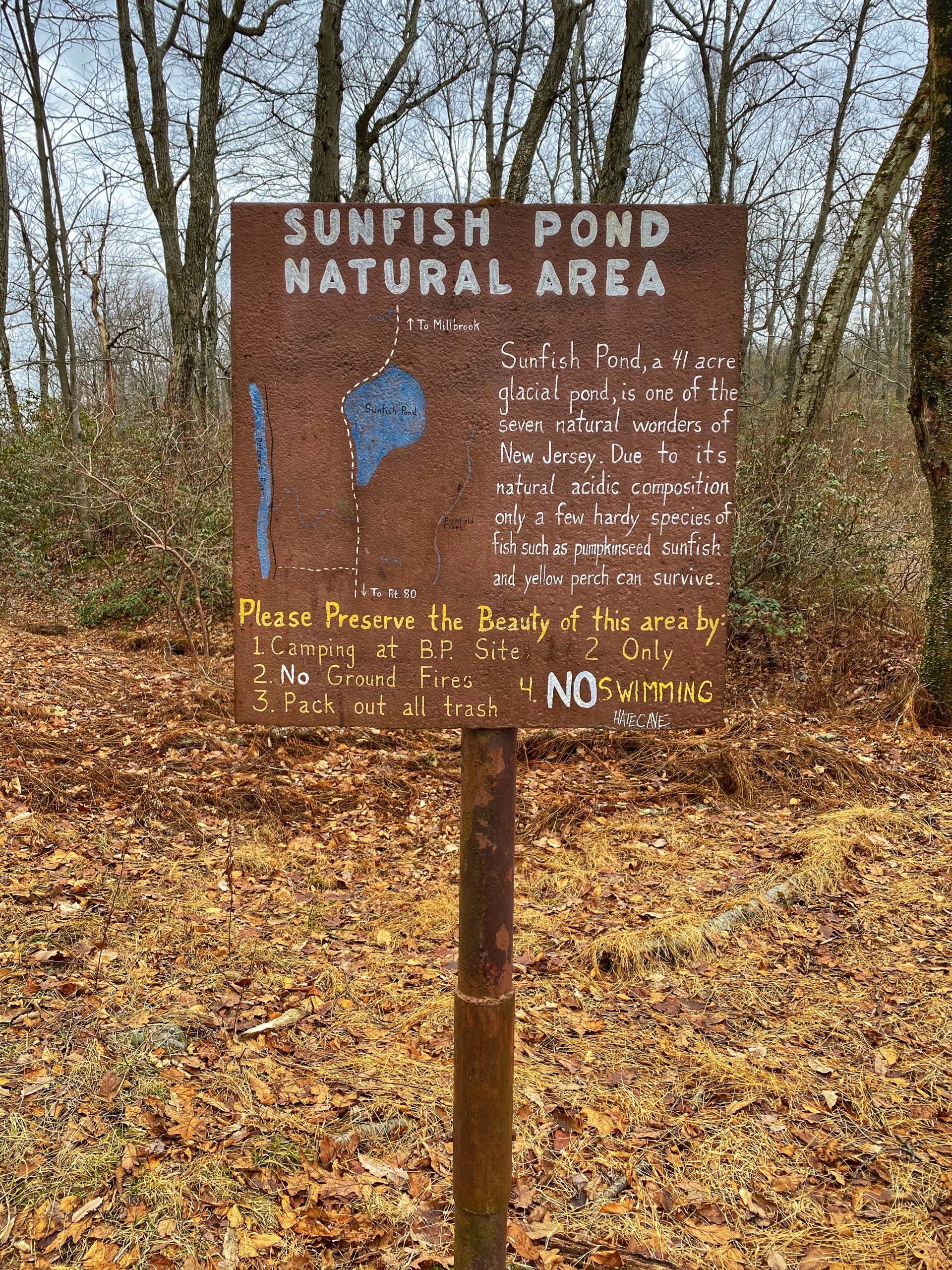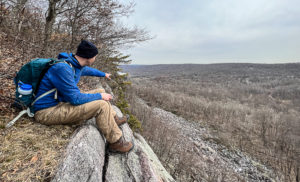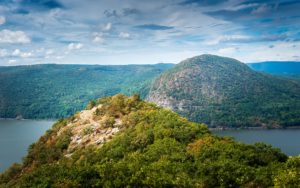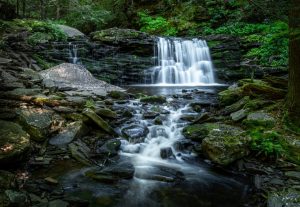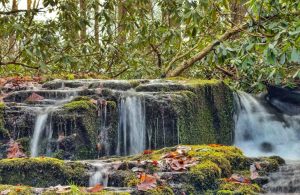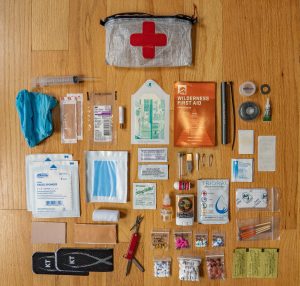Before the EPA or the first Earth Day, a future Republican governor helped save the glacial lake Sunfish Pond and kickstart New Jersey’s environmental movement
“I was a conservationist before they invented the word environmental”
– Thomas H. Kean, Sr.
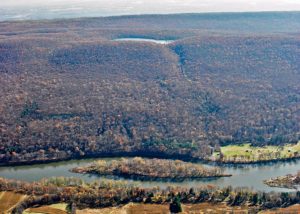
Sunfish Pond is a 44-acre spring-fed glacial lake surrounded by hardwood forest near the summit of Kittatinny Mountain in Worthington State Forest near the Delaware Water Gap National Recreation Area. Perched at 1,379 feet, the National Natural Landmark is notable as the southernmost glacial tarn along the Appalachian Trail and for its naturally acidic water that only supports certain species of fish.
The lake’s threatened demise kickstarted New Jersey’s nascent environmental movement into overcoming incredible odds to save what has been called one of the Seven Natural Wonders of New Jersey.
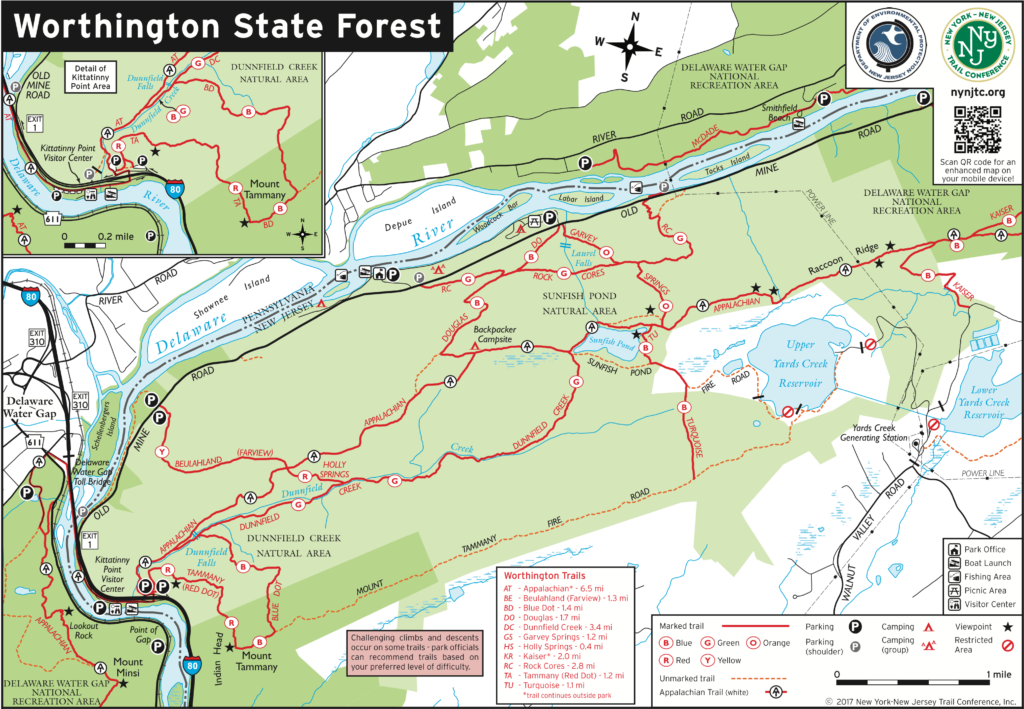
Hikes to Sunfish Pond
- Mt. Tammany and Sunfish Pond loop
- Delaware Water Gap – Appalachian Trail
- Garvey Springs & Douglas Trail loop (the shortest, but steepest route)
- Mount Tammany Trail (nearby, but does not pass Sunfish Pond)
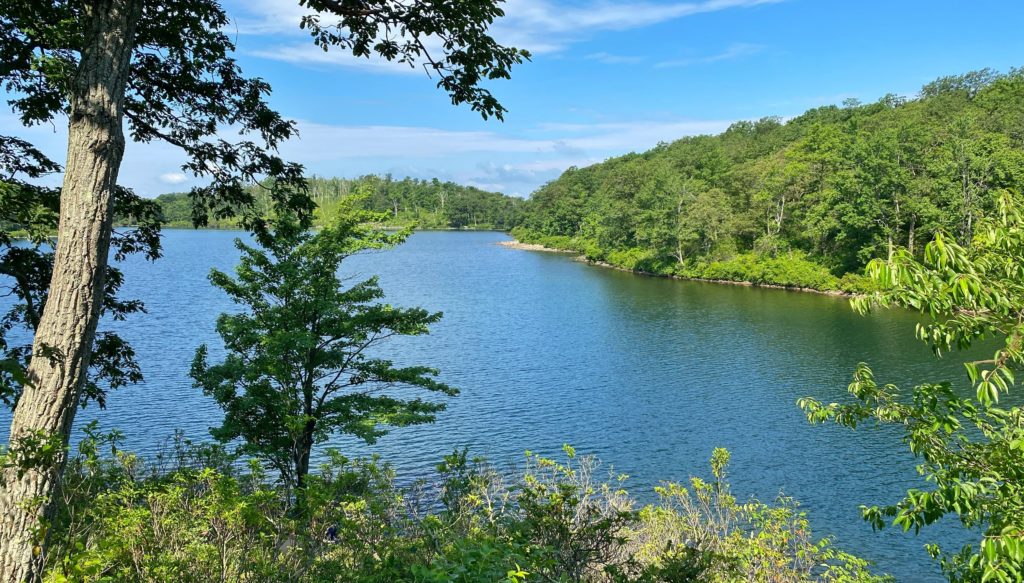
History
About 18,000 years ago near the end of the last ice age, the retreating Wisconsin Glacier scoured a deep bowl into the Kittatinny Ridge, which would fill to form the 60-foot deep Sunfish Pond. The Minsi Indians fished here since they arrived 800 years ago.
In 1870 Sunfish Pond was described as “a sheet of pure transparent water…strangely and unaccountably situated on the very Summit of the mountain….The lake is reached…by a rugged mountain path, accessible to all who have stout limbs and good lungs, and desire to have these requisites of healthful existence continued.”
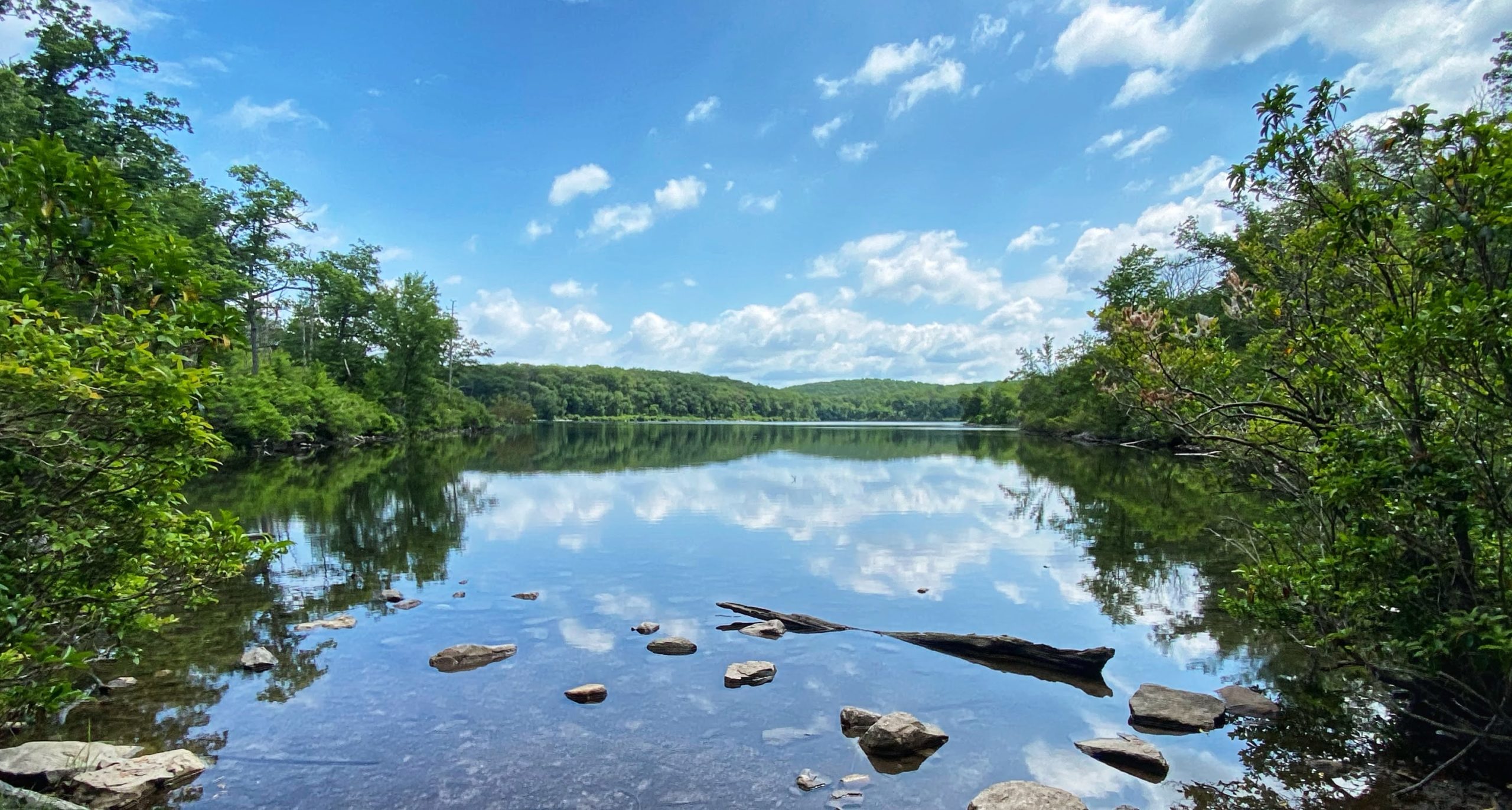
In 1890, Sunfish Pond and 708 acres of the surrounding land were purchased by millionaire Charles C. Worthington, president of the Worthington Pump Corporation. In 1903, Worthington, acquired 8,000 acres on both sides of the Delaware River. He built a small mansion (called Buckwood Lodge) on a hillside half way between the river and Sunfish Pond (which supplied the water for the mansion). At that time, he called the pond Buckwood Lake. (Buckwood Trail, formerly the Turquoise Trail, connects the Appalachian Trail with the Mount Tammany Fire Road.)
In 1954, the Worthington family sold the Worthington land tract, including the Sunfish Pond area, to the State of New Jersey. Seven years later, the State sold 715 acres of the tract, including Sunfish Pond, to Jersey Central Power and Light for $250,000.
And that’s when things got interesting.
About Sunfish Pond
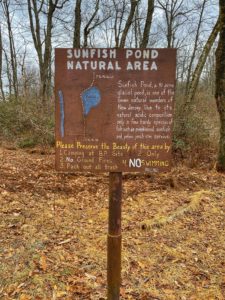
A handwritten sign near the southern end of the lake provides basic information on the pond and informs visitors that “Due to its natural acidic composition only a few hardy species of fish such as pumpkinseed sunfish and yellow perch can survive” in the lake. The high acidity is said to inhibit marine and plant life.
The pond has an outflow that drains – even during dry years – through a natural rock weir at the northwestern edge of the lake and which regulates the height of the lake. The outlet flows across the Appalachian Trail – a very rocky section of the trail which skirts the west of the lake – and is a convenient site for hikers to collect and treat water. The lake drains into the Delaware River below.
Bill Bryson discusses Sunfish Pond in his New York Times bestselling book about the Appalachian Trail, A Walk in the Woods:
For northbound hikers Sunfish Pond is something of a glorious novelty, since nowhere south of here will you find a body of water on a mountaintop. It is in fact the first glacial feature northbound hikers come across. During the last ice age, this was about as far as the ice sheets got. The farthest advance in New Jersey was about ten miles south of the Water Gap, though even here, where the climate would let it go no farther, it was still at least 2,000 feet thick.
Imagine it—a wall of ice nearly half a mile high, and beyond it for tens of thousands of square miles nothing
A Walk in the Woods
but more ice, broken only by the peaks of a very few of the loftiest mountains. What a sight that must have been
Although the pond has a naturally acidic composition, with a pH between 4.3 and 4.0, treated water is safe for human consumption (The pH of most sodas is less than 4.0).
A rich variety of fauna can be found in and around the lake, include frogs, snakes, deer, black bear, and beavers.
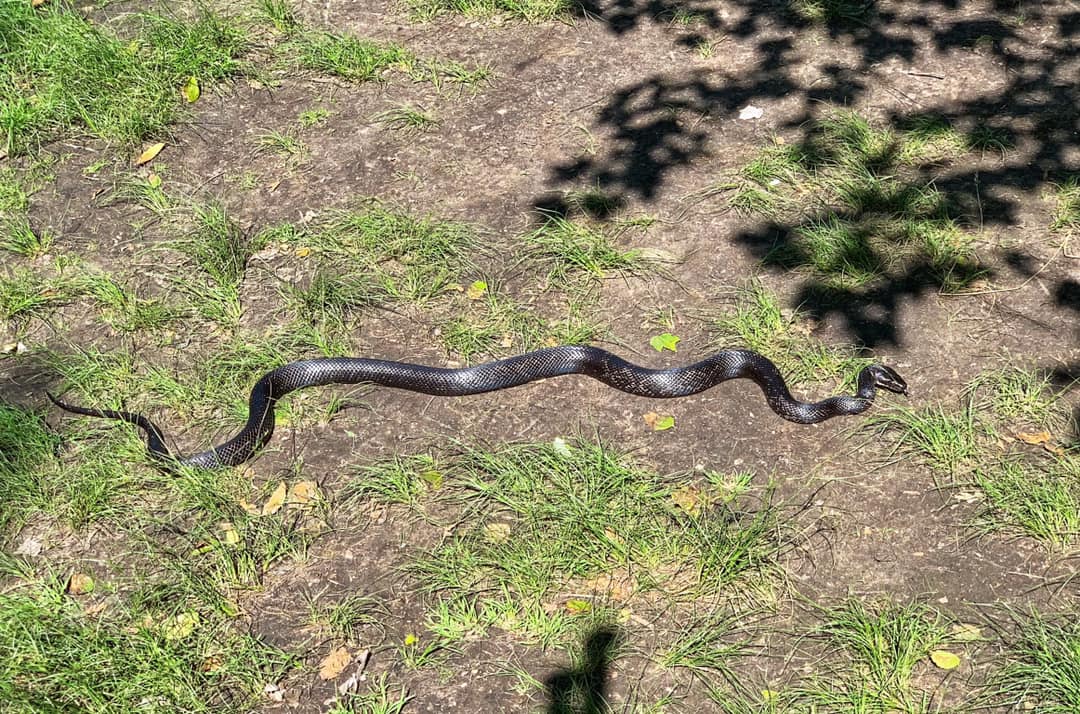

Threats from “recreation experts”
Due to the high acidity of the lake, Sunfish Pond “originally hosted only a few hardy species of fish, including pumpkinseed sunfish, chain pickerel, yellow perch, and brown bullheads.”
In a sign of how backwards the environmental thinking was at the time, the natural biodiversity of the lake was considered a problem that needed to be corrected if the lake was to have any value to outdoor enthusiasts.
It is a little known fact that while the pond was owned by the power company, the New Jersey Division of Fish and Game tried to chemically alter the make-up of the pond. In an attempt to place new species of fish in the pond (especially trout), the chemical “rotenone” (a natural fish poison that works on contact) was introduced, the pond’s chemical composition was radically altered. Repeated attempts to stock the pond with rainbow and brook trout failed. The poison killed not only the original fish, but also the newly introduced trout. The rotenone was such a strong chemical that the plant life necessary for the survival of the fish was also destroyed; Sunfish Pond was basically a biologically “dead” lake.
Charles Campbell Worthington (1854 – 1944): History of Worthington State Park
Approximately a thousand pound of native fish were killed. As a result of the poison which killed both fauna and flora, Sunfish Pond was “virtually sterile and considered of little value to the state’s recreation (i.e. trout fishing) experts.”
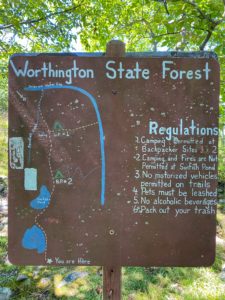
The lake also came under pressure from heavy use. “During the 1960s and early 1970s so many people were drawn to the beauty and “isolation” of this area near Sunfish Pond that the surrounding natural area was quickly trashed. Strict control needed to be placed over the area in an attempt to keep it in its natural state.”
Two designated camping sites were built – although only one – Backpacker Site #2, at the junction of the Appalachian Trail with the Douglas Trail, remains today. The other camp site, near the junction of the AT and the Fairview Trail, no longer exists. Swimming in and camping around the lake remains prohibited.
But Sunfish Pond’s greatest threat wasn’t from too many visitors or the misguided attempts to alter the lake’s biodiversity, but rather another one of man’s attempts to control nature.
Tocks Island Dam
When the park was sold to the State of New Jersey in 1954, “the original agreement provided that the land would be left in its natural state, and unspoiled by commercial development. Unknown to many, this verbal (nothing was put down on paper) agreement went unheeded.”
The Delaware River is one of the few remaining free-flowing major rivers in the country, but following the devastating Flood of 1955, Congress passed the Flood Control Act, and the Army Corps of Engineers “proposed to dam the Delaware by constructing an earth-filled dam at Tocks Island. As part of the project, a hydroelectric plant was proposed.
In 1961 the property was resold to the New Jersey Central Power and Light Company for the development of a proposed hydroelectrical plant. If this plant had been constructed the pond would have become the reservoir, surrounded by high retaining walls with large pipelines running down the mountain to the Delaware River.”

“Save Sunfish Pond”
The Tocks Island Dam project was introduced quietly, but word began to spread among a small group of local residents.
In 1965, while the Tocks Island dam idea was very new, Glenn Fisher and Casey Kays began telling people about Sunfish Pond…The two men, along with Thomas Ritter, formed the Lenni Lenape League and began the fight to save Sunfish Pond. The fight for the pond became the first grassroots effort to have a major impact on future New Jersey conservation practices.
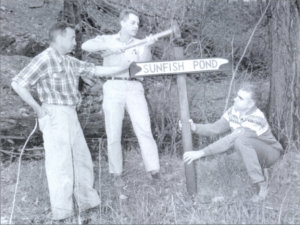
On Mothers Day, 1966, the group held their first public event – a pilgrimage to the pond. Hundreds joined. More hikes would follow.
The New Jersey Audubon Society, an early supporter of the fight to save Sunfish Pond, said the lake “personified the unspoiled natural beauty of America” and called it “one of the most scenic treasures in New Jersey.”
These advocates found an unlikely ally in the New Jersey legislature who would champion their cause.
A Freshman Republican Helps Spark an Environmental Movement
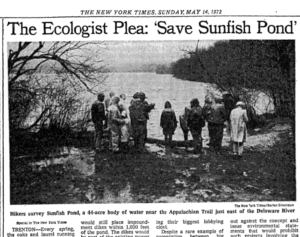
Thomas Howard Kean, Sr, who would go on to become New Jersey’s 48th – and most popular – governor, played a pivotal role in saving Sunfish Pond as a newly-elected member of the New Jersey Assembly.
Elected to the State Assembly in 1967 – before the EPA came into existence or the first Earth Day was celebrated – Tom Kean Sr, the son of a Republican congressman and a nature lover, would step up as a leading environmentalist in New Jersey government and in the process helped to kickstart the Garden State’s conservation movement.
By risking his political future on the widely ridiculed cause of environmentalism in an industrial state, Kean not only secured for posterity a unique natural wonder, but also charted a new course for the identity and future soul of the Garden State.
Upon being elected to the Assembly in 1967, one of the first issues Mr. Kean championed was saving Sunfish Pond. From Governor Tom Kean: From the New Jersey Statehouse to the 911 Commission:
Early in his legislative tenure, Kean learned that a consortium of power companies planned to incorporate [Sunfish Pond]…into a pumped storage reservoir….In addition to the power companies, the plan had the support of business, labor, the Army Corps of Engineers, and the governors of the four surrounding states.
For a time, it appeared that the only group that thought the lake was worth salvaging was a small group of conservationists who comprised the Lenni Lenape League. For several years, they had been staging annual “Save Sunfish Pond” public programs and events. What it lacked in funds and political clout, the group made up for in media savvy. In 1967, at its invitation, Supreme Court justice William O. Douglas…led a much-publicized hike there.
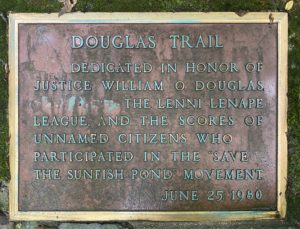
“It’s a vital element in the need to save some of our wilderness from the encroachment of civilization.” said Justice Douglas. More than 1,000 people joined the second-annual hike to the pond.
Today, a trail in Worthington State Forest is named in honor of Justice William O. Douglas. The Douglass Trail provides one of the shortest routes to Sunfish Pond. “Once the trail reaches the Appalachian National Scenic Trail, head north (left) for about three-quarters of a mile to reach Sunfish Pond.”

More from Governor Tom Kean:
[In addition to Justice Douglas,] Former interior secretary Stewart Udall had spoken of the area’s special beauty. Yet no one with the power to spare Sunfish Pond was prepared to intervene on its behalf. That remained the case until Tom Kean came on the scene.
Kean introduced a bill authorizing the state to reacquire 390 acres of the 715-acre tract it had sold to the power company. “The legislators will have to decide whether they will go with the special interest groups or not,” he proclaimed upon introducing the measure. Kean would steer the bill through the assembly four times in four consecutive years, each time with a larger number of cosponsors than the last, only to see it die in the senate.
Initially, Kean was stung at the intensity of the opposition his measure aroused and by the tactics those who favored the plan used to thwart him. Essex County Democratic assemblyman Paul Policastro announced on the assembly floor that the people of Kean’s district had sent a bird watcher to Trenton. Industry and labor spokesmen cited the need for additional electricity, predicting brownouts if the project did not go forward. One Hudson County Democratic legislator – and employee of Public Service Electric and Gas – said that unless the power companies expanded their existing pumped storage facilities along the Delaware, they would have no alternative other than to “lead New Jersey down the road to darkness.” Utility lobbyists swirled around Kean to “explain” the project to him. “They kept thinking I didn’t understand [the proposal], he said years later. After they had concluded that he had, they assumed Kean was trying to hold up the project as a means of extracting concessions from colleagues on another piece of legislation. Upon learning that that was not the case, they charged that Kean was acting to protect his family’s interests. After he told them that the utility companies his family owned and operated favored the project, they began referring to him as a traitor to business as they advanced various psychological theories that might account for his apostasy.
When Kean showed up for a meeting with industry lobbyists, wearing a bandage on his arm, one inquired into the cause of his injury. ‘A bee sting,’ Kean replied. ‘It should have gone right to your heart,’ the lobbyist blurted out, only half in jest. Soon major Republican donors were calling Kean to explain that his actions would mean the ruination of the party. ‘They kept thinking I didn’t understand,’ he recalled. ‘And the more they opposed me, the madder I got…I just got my teeth into it, and I wouldn’t let go.
Kean pushed on many fronts. He worked the press. (‘It was a wonderful issue to talk about,’ he said.) Though still a freshman legislator, he began to apply some of the media savvy he had observed in others while toiling on Bill Scranton’s behalf four years earlier. ‘They were destroying something that had been there from the ice age,’ Kean would say decades later. Such lines, especially when uttered with the earnest intensity that Kean exuded, attracted much ink. He took the battle beyond New Jersey borders, surprising his adversaries when he persuaded U.S. senator Clifford P. Case to withhold support for a utility-initiated rider to a Senate Rivers and Harbors bill that would have authorized the project.
After a hastily convened summit, which included both of the state’s U.S. Senators, Hughes, the executive director of the Delaware River Basin Commission (a consortium of the state governments of Delaware, New Jersey, New York, and Pennsylvania), industry representatives, conservationists, and Kean, the companies modified their proposal. Instead of developing Sunfish Pond, they offered to relocate the pump storage facility to an alternative site. To make their plan work, they would draw water one thousand feet up the mountain and construct a gigantic dike.
Kean and the conservationists refused the compromise, arguing that seepage from the pumped Delaware River water would introduce algae into Sunfish Pond, destroying the pristine quality. They also worried about damage the shift would cause the surrounding watershed and maintained that the project would deface the top of the Kittatiny mountain range. ‘Nobody can argue against cheap power,’ Kean said in a prepared statement to a U.S. Senate committee, ‘but at what price?” The loss of natural assets that can never be replaced.’ Back home, Kean complained of being subjected to ‘one of the most intense lobbying efforts’ he had ever seen. The coalition in favor of the project included the two largest power companies in the state (JCP&L and Public Service Electric and Gas), the Chamber of Commerce, the Delaware River Basin Commission, four sitting governors, and the state AFL-CIO. Former governor Robert B. Meyner, whose administration had both purchased the Worthington tract and made the decision to sell part of it to the utilities, and Conrad L. Wirth, former National Parks Service director, served as advisers to the power companies.
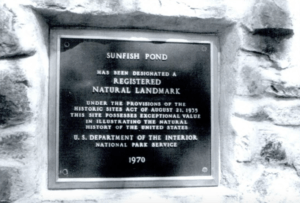
In 1970, the U.S. Department of Interior designated Sunfish Pond a National Natural Landmark and in 1973, a native stone monument was erected at the southern part of the pond with a plaque noting the designation.
Though Kean would attend the dedication ceremony, he didn’t consider the designation sufficient to protect the lake.
While the new national designation of the pond does not provide the ironclad environmental‐protection guarantees contained in the Kean measure, it nevertheless affords some degree of protection, state environmental officials said….For example, if the power companies or anyone else made any move to encroach on the pond now that it is a national landmark, they could be blocked by the Department of Interior, the officials said….Mr. Kean said, however, that the national designation “provides no environmental protection at all.”
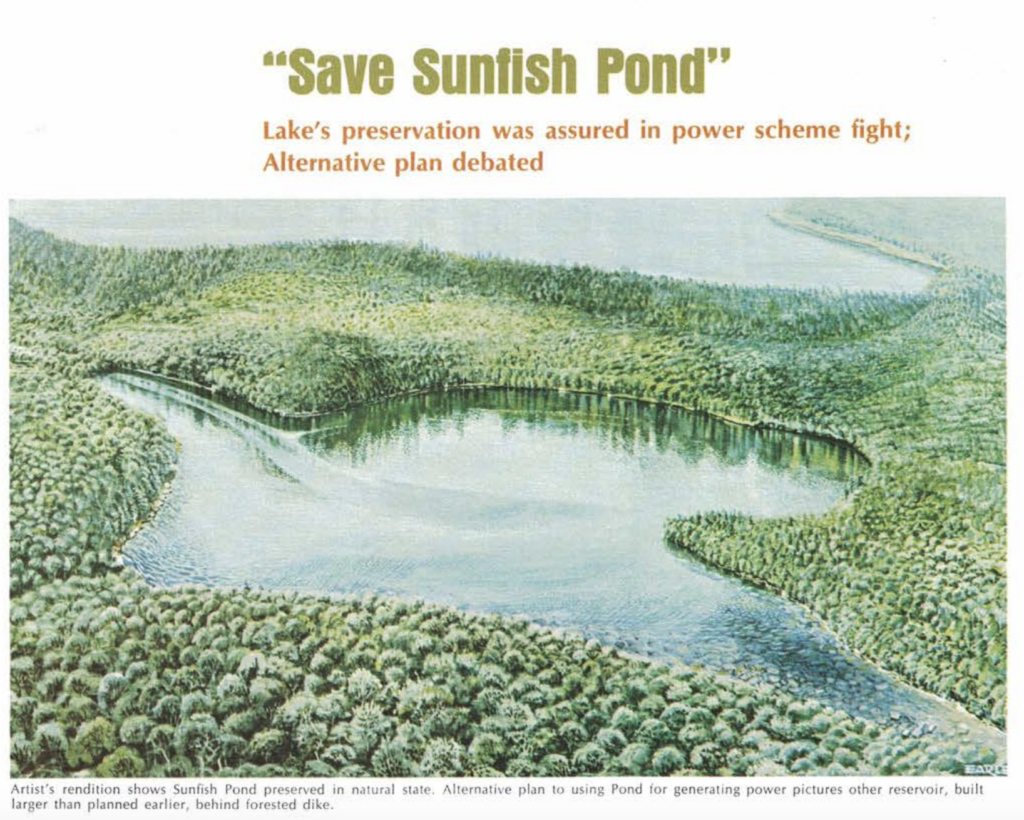
Continued from Governor Tom Kean:
For Kean, Kays, and their allies, victory ultimately came in 1972 when Governor William T. Cahill, citing excessive costs, risks of overdevelopment, and environmental concerns, withdrew New Jersey’s support for the entire Tocks Island Dam project. The thread on which Kean had been pulling while a freshman assemblyman and continued to tug as he rose through the assembly’s ranks had, by the time he became its Speaker, unraveled an entire tapestry that had been years in the making. With information supplied by friends in the conservation movement and others, Kean discovered that agricultural runoffs from dairy and poultry farms in New York State containing pesticides threatened to pollute the entire man-made lake the Army Corps of Engineers prepared to create through its construction of the Tocks Island Dam. To prevent the runoff and its contents from seeping into tributaries flowing into the reservoir, New York State would have had to control the use of pesticides or construct sewage treatment plants, at a cost of billions of dollars, to remove the pollutants. Unwilling to construct this dilemma, New York governor Nelson A. Rockefeller, once the dam’s most enthusiastic backer, suddenly lost interest in the project. Kean described his efforts to save Sunfish Pond as the “mouse that slew the [Tocks Island] mountain.”
‘They [the corporate lobbyists] forced me to look at the whole project,” Kean said years later. “A beautiful part of the state would have been under water. It just did not make any sense. The benefits were not there. The whole thing was not what it was cracked up to be.” He would come to regard the battle to save Sunfish Pond as the catalyst that sparked the emergence of the environmental movement in New Jersey. He explained: “What started out as a little bill turned into a major bill. That was a process leading up to all the efforts to preserve the wetlands and the creation of the Department of Environmental Projection. For all those other bills I put through, that was sort of the lead. And in the middle of the fight, Earth Day was passed nationally. Rachel Carson’s Silent Spring [had] become very popular.”
Over the ensuing years, the project slowly met its final demise. In 1975, the Delaware River Basin Commission voted 3 to 1 against constructing the Tocks Island Dam.
In 1978, the Delaware River became part of the National Wild and Scenic Rivers System. That meant that to dam the Delaware, the Wild and Scenic designation would have to be put aside by Congress.
Finally, on July 18, 1992, Congress deauthorized the Tocks Island Dam Project.
Epilogue for a Natural Wonder
After two rounds of poison wiped out all the life in the lake, an effort was made to restock the native fish. There were several years of uncertainty when it wasn’t clear if the fish had made a comeback, but now it’s easy to spot fish from the shores of Sunfish Pond.

In 1978, the New Jersey Historical Society and over two thousand New Jersey secondary school students voted to designate Sunfish Pond one of the Seven Natural Wonders of New Jersey.
In 1978 and 1979, Assemblyman Richard Van Wagner introduced a bill to make the “Seven Natural Wonders of New Jersey” designation for Sunfish Pond official, along with the Great Falls in Paterson, the Palisades, the Pine Barrens, the Jersey Shore, the Delaware Water Gap, and High Point.
The bill never received a vote.
Recently, the increased popularity of the Delaware Water Gap National Recreation Area has led to overcrowding and damage to ecological areas, prompting the National Park Service to consider – and ultimately reject – instituting an entrance fee for the park.
